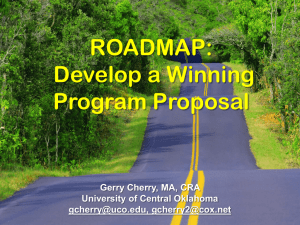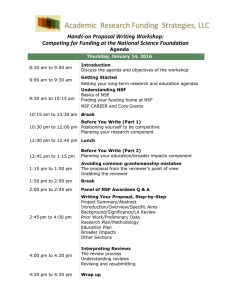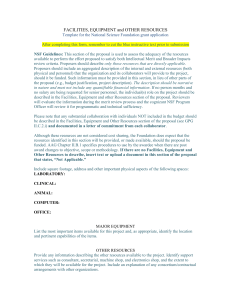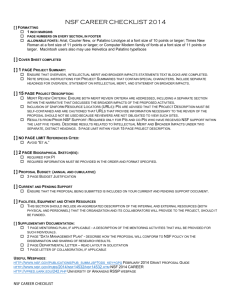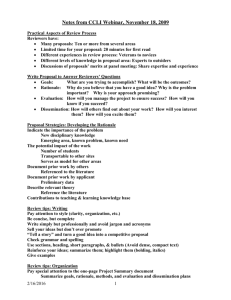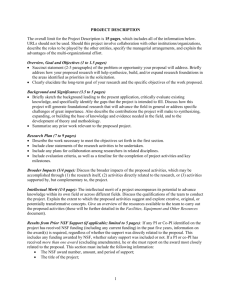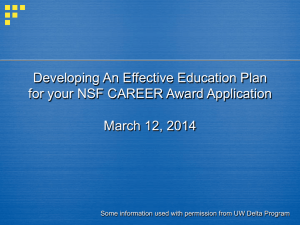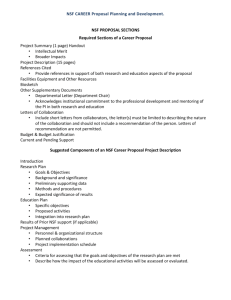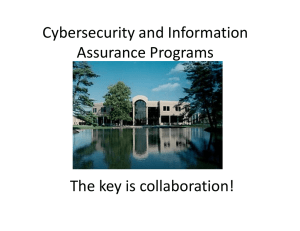Writing an Effective Research Grant Proposal
advertisement
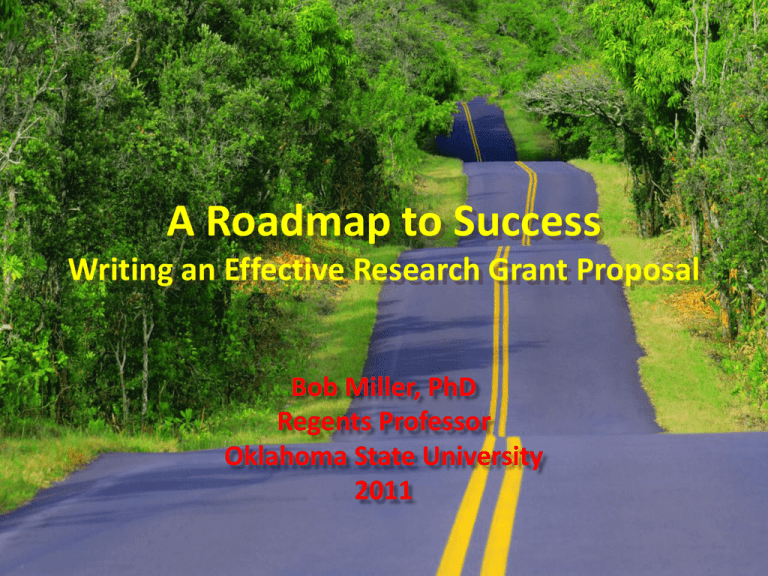
A Roadmap to Success Writing an Effective Research Grant Proposal Bob Miller, PhD Regents Professor Oklahoma State University 2011 Getting Started Think. What do you want to do? Will the proposed research impact significantly on the field and can you convince others that it will? Do you have an adequate foundation of preliminary data to launch a grant application? Getting Started If Yes… Outline three or four concise Specific Aims. Getting Started NOW ––––––––––– FORGET about it! Find something else to do for a while! Getting Started – Planning Now, think about it again…. Assess your field. Do you want to go it alone or are there opportunities for collaborating with a more experienced grantee? Check out the competition! http://www.nsf.gov/awardsearch/index.jsp http://crisp.cit.nih.gov Getting Started – Planning Evaluate yourself. How do your strengths match up with the topics you uncovered in your database search? Can you capitalize on your expertise and fill in any gaps with mentors, consultants or collaborators? Resources and support What does your organization have and what other support will you need? More Planning Find two colleagues. One should be dead-on in the discipline that is the topic of your nascent grant application. The other should be generally conversant with the field, but not an expert in the subject area of your planned application. Both should be experienced grantees, preferably from the agency to which you are applying. At least one should be on your campus. Planning with Colleagues Now, talk with both of them about your ideas for a grant application. Ask them if they will share a successful grant they have written. Show them your specific aims. Show them your recent peer reviewed publications that are relevant to the subject matter of your proposed. True colleagues will be critical as well as being supportive. Don’t be thin skinned! Don’t be reluctant to revise your plans as needed. Don’t feel obligated to follow their advise….. Planning Find an Agency and Program See if your proposal matches any specific initiatives at the relevant granting agencies. Call or email a Program Officer for an opinion of your idea. What you want to propose is not always what is most important. What is important is finding a program that can fund what you want to propose! Schedule a follow-up phone conversation or videoconference. Visit if possible. Getting Started on the Real Thing Learn from the RFP! • What does the funder support? • What does the funder expect? • What resources are available now? • 1. Institutional Support • 2. Institutional Commitment • What is the Application Process? • What is the Selection Process? • Who you gonna call? OK, Sit Down and Start Writing With all this and more in firmly in mind, at some point you actually have to start writing the darned thing. Write the application in the Project Description sequence. But, if you get stuck, move on to another section. Write the Summary last, but not at the last minute. It’s the one thing everyone reads. THE WHOLE STORY BUDGET BUDGET JUSTIFICATION EVALUATION THE STORY INSTITUTIONALIZATION DISSEMINATION NSF MERIT REVIEW CRITERIA INTELLECTUAL MERIT • DOES IT ADVANCE KNOWLEDGE? • HOW QUALIFIED IS THE PROPOSER? • DOES IT EXPLORE CREATIVE CONCEPTS? • HOW WELL IS IT ORGANIZED? • ARE THE NEEDED RESOURCES AVAILABLE? BROADER IMPACT • DOES IT PROMOTE TEACHING AND LEARNING? • DOES IT INCLUDE PARTICIPATION OF OTHERS? • WILL THE RESULTS BE BROADLY DISSEMINATED? • HOW WILL SOCIETY BENEFIT? Criterion 1: What is the intellectual merit of the activity? Potential Considerations: • How important is the proposed activity to advancing knowledge and understanding within the field or across different fields? • How well qualified are the team members to conduct the project? Is it well organized? • To what extent does the proposed activity suggest and explore creative, original, or potentially transformative concepts? • How well conceived and organized is the proposed activity? • Is there sufficient access to resources? Why is it Unique? – How is it Novel? Who makes up the Interdisciplinary Team? Criterion 2: What are the broader impacts of the proposed activity? Potential Considerations: •How well does the activity advance discovery and understanding while promoting teaching, training, and learning? •How does the activity include participation of underrepresented minority groups? •To what extent will it enhance infrastructure? •Will the results be disseminated broadly? •What may be the benefits of the activity to society? PROPOSAL REVIEW Principal investigators should address the following elements in their proposal. • Integration of Research and Education One of the principal strategies in support of NSF goals is to foster integration of research and education in funded projects through the programs, projects, and activities at academic and research institutions. • Integrating Diversity into NSF Projects Broadening opportunities and enabling the participation of all citizens is essential to the health and vitality of science and engineering. The Parts (NSF) A. Project Summary B. Project Description 1. Objective and Significance 2. Background 3. Preliminary Results 4. Research Plan 5. [Conclusions] 6. Broader Social Impact and Educational Outreach 7. Results of Prior NSF Finding Before we begin! READ THE RFP or APPLICATION GUIDELINES AGAIN!!!!!! FONTS THAT CAN BE USED PRINT SIZE PAGE LIMIT Project Summary • Stand alone – This may be the only thing that most of the panel reads. • Read the guidelines – Tells you what should be in it. – Word or character limit is often included. Objectives & Significance • HIT THEM IN THE FACE! • Include why you want to do the study and why it’s important. • HYPOTHESIS DRIVEN! !!!!!!!!!!! • Goals – The activities you are going to do to test the hypothesis – Not more than 3-4 (Maybe 5). Don’t try to do everything! Background • The state of knowledge at the current time. • Make sure that the literature survey is complete. (Literature cited is not included in page limit). Preliminary Results • Important • What you have done at the current time • Include enough data to be convincing but summarize. • Cite your papers! – Especially if they acknowledge a former or current grant from the agency. Research Plan • Follow your “Goals” from the introduction • Provide enough detail that a person not in the field understands the procedures • What do you expect (hypothesis)? • What do you do if you don’t get the results you expect? • What are the potential pitfalls? Facilities Statement • What resources do you have? • Can you do the project with what you have? • If you can’t, you need to think about what you need and include it in the budget. Budget Must be reasonable for what you want to do – Not enough is as bad as too much! – If you need a piece of equipment, include it. – If you need to contract something out be sure to include costs Don’t forget – Fringe benefits – Travel – Publication costs. Budget Justification • • • • • • Important! What is everyone going to do? Why do you need what you need? Why do you need the travel funds? What rate will travel be reimbursed? Work with your grants office!!!! THANK YOU
